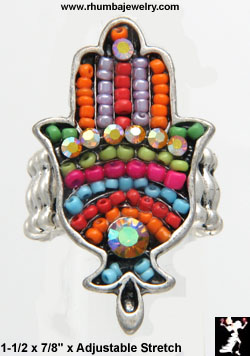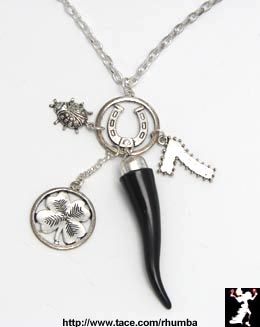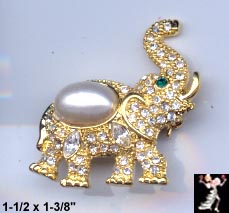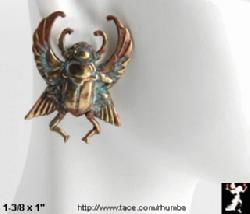Here are a few traditional charms to choose from:
Horseshoe

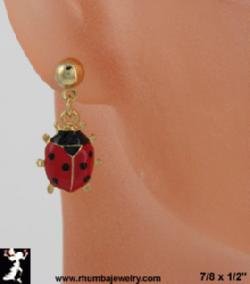


A horseshoe is considered lucky because of its shape, relative to that of a crescent moon, which was regarded as a protective shape in ancient civilizations. Because horseshoes were often made of iron, it is also a symbol of strength. There are seven holes in a horseshoe, and many regard seven as a lucky number due to its many references in ancient and religious texts. The luckiness of the horseshoe may also be attributed to the horse itself. One wears a horseshoe in order to invoke a horse's steadfast and bold qualities.

In Chinese culture, jade is believed to be the only material that contains both yin and yang qualities - and as such, links the physical and spiritual worlds. Jade is worn to absorb bad chi, and protect against sickness. Because of its link to the supernatural, it is believed to guard against evil spirits. For these reasons, babies are often given a jade bracelet at birth.

It's unclear exactly why ladybugs are considered lucky. I'd like to think it's because they're incredibly stylishly-outfitted insects. :)
Ladybugs are most likely considered lucky because they are natural predators to garden pests, so ladybugs in the crops mean a good growing season.
Everybody eats, so perhaps that's why nearly all cultures see the ladybug as good luck!
This symbol is popular among Middle Eastern, North African, and Jewish cultures. It is also know as The Hand of Miriam, The Hand of Hasma, and The Hand of Khamsa. It is said to ward off the "evil eye." You know the "evil eye." It's that look other people give you when they are envious of your fabulousness.
Khamsa in Arabic means "five". There is an Arabic phrase that is supposed to nullify bad luck, loosely translating to "put five fingers in the evil eye."
In Jewish culture, the symbol represents the five books of the Torah. It is also said the symbol reminds people to celebrate God with all five senses.
It is believed that the evil eye can be so strong, it causes illness and death to those it is directed towards. Wearing the Hand of Fatima is like telling all that negativity to "talk to the hand."
The Italian corno is another defense against the infamous "evil eye." Corno means horn, and is believed to reference the ancient Roman moon goddess Diana, who was also protector of horned animals (she is often depicted running with deer), nature, and childbirth. Young women would wear the horn to invoke the goddess' protection, especially if she is expecting a child. Often referred to as a chili pepper by those not familiar with the lucky symbol, as it is often seen in red, the color of fertility. Though it is originally a pagan symbol, the corno still a popular symbol of good luck among Roman Catholics.
The "Trunk Up Elephant Charm" is a popular lucky symbol in created by the West, though the origins of its mysticism are rooted in Eastern culture. The Hindu god of luck, Ganesh, has an elephant head and man body. His trunk is often depicted pointing upwards. Perhaps when the British colonized India, they adopted this cultural icon, though manufactured an elephant animal because they did not simultaneously adopt the religious beliefs. The trunk points upward because some European cultures believe that if a lucky symbol points downward, your luck will run out.
The Ancient Egyptians believed evil was everywhere, which is why they had so many rituals and wore amulets - to ward off the evil and change their fate to fortunate. The scarab is modeled after the dung beetle, which is unappetizing, I know, but these insect's instinctual rituals are interesting, and I can see why the Egyptians would use them as a symbol of good luck. Dung beetles build their nests by rolling, well, dung. The eggs are buried deep in the center of their dung-nest-ball and mature as the dung dries in the sun. When the babies are mature, they spring forth from the darkness of their dung nest. Thus, they are closely associated with new beginnings, self-creation and the positive energy of the sun. The scarab was sacred to the ancient Egyptians, and is seen beautifully depicted throughout the ancient culture's art, myths, and elaborate tombs.

Last but not least, the four-leaf clover is considered lucky because it is a rare find. There is approximately one four-leaf clover for every 10,000 common three-leaf
clovers. Legend has it that the first woman, Eve, carried a four-leaf clover from the sacred Garden of Eden. Each leaf has been given meaning: hope, faith, love, and luck.
Some people are quick to dismiss the powers of a lucky charm. Some believe you create your own luck.
Perhaps when you wear "lucky" jewelry, you, yourself, c
reate an air of confidence around you because you believe in its magic - so much so that positivity and good fortune are naturally attracted to you.
Basically, when you look good, you get lucky.
Everyone can believe in that.
;)
